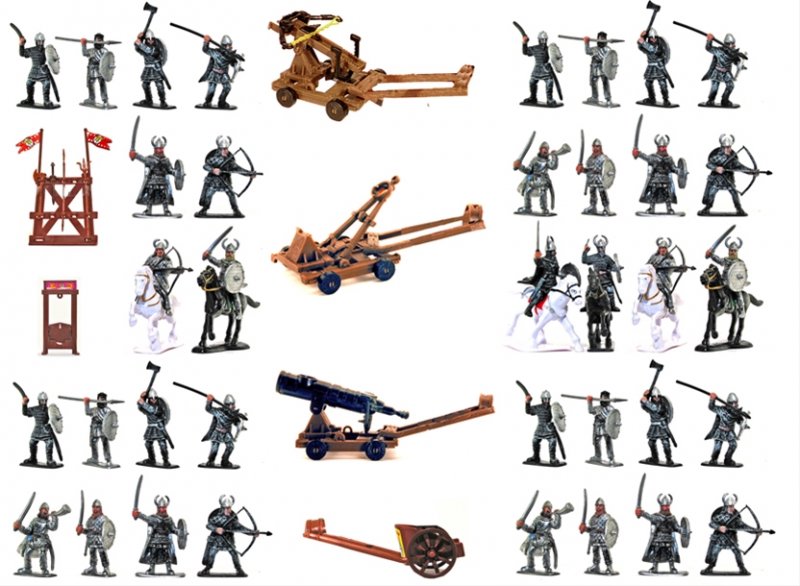Rules for Medieval Toy Soldiers
Introduction
"Ringmail" was an improbable historical construct. So too these rules are an improbable match to anything historical. But they sure are fun!
Scale
Toy soldiers are 1:32 scale; that is 2&¼" or 54mm.
Field of Battle
Arrange a field of battle anywhere from 6' to 24' in dimensions. Determine battle line between opposing sides in roughly the middle of the field. Each side has a starting line set back from the battle line equivalent to that of their opponent's and no less than 24." Main stronghold, camp or pavilion of each side no more than 12" back from respective start-lines. Scale of play is such that terrain types and penalties make little sense. Distribute interesting obstacles for tactical use. Recommended: felt battle mat marked with 2" hexes; model trees, blue ribbon for rivers, etc.
Composition of Forces
Each side has one or two engines of war. Arrange each side with troop types falling roughly within the following ratio:
1 Archer : 3 Cavalry : 5 Infantry
Turn Sequence
- Engine
- Range
- Melee
- Move
All actions simultaneous. Alternatively, players determine initiative for movement by opposing check. First turn: move only. Second turn: move and melee (if any). Third turn adds range. Fourth and all subsequent turns: all four phases.
Movement
- Engine 3"
- Archers 6"
- Infantry 12"
- Cavalry 24"
Range & Melee
Range fire and melee resolved with modified rock-paper-scissors:
- Archer removes cavalry (24" range)
- Cavalry removes infantry
- Infantry removes archer
All other melee resolved on opposing check: loser removed; both remain on ties. Note the following exceptions:
- Cavalry and archer opposing check in melee
- Both archers remain when attacker losses opposing check against archer not returning fire
- Flank (side) or surprise (rear) attack of lesser to greater allows opposing check
- E.g., infantry flanking cavalry resolved by opposing check
Engine
- Redo misfires
- Remove any figure hit by projectile
- Remove engines hit by opposing engine fire
- Take engines with two or more troops of opposing side on successful opposing check
Morale
Check a force's morale at the top of every turn after reduced beyond half its original line-up: maintain morale on 2d6 = 7+ otherwise morale lost.
End
Battle ends when one or both sides:
- Losses morale
- Reduced to less than a third its original line-up
- Surrenders
Victory
Victory goes to the side that:
- Does not loose morale
- Is not reduced to less than a third its original line-up
- Does not surrender
Otherwise a draw. Alternatively, other end and victory conditions may be agreed upon; e.g., attaining some goal such as capturing an object or flag, etc.
Sieges
Make walls with gates and even some wall-portions that engine fire can topple. One additional engine to the defender but defender starts with one third the troops of the besieger. Imagine any foot soldier positions along a wall or upon a parapet as capable of range fire, whether depicted with range weapon or not.
Point Values
- Engine 5
- Cavalry 4
- Archer 3
- Infantry 2
Setting up a Medieval Toy Soldier Wargames Campaign
Each side starts with 50 points to acquire starting forces. Note guidelines to composition of force, above. After each battle, save for the return of removed troops on 2d6:
- Engine 6+
- Cavalry 6+
- Archer 7+
- Infantry 8+
Victor gets 20 points, looser 10. Capture of opposing "baggage" or some other such treasure, object or goal grants 5 points. Each side of a draw gets 15 points. Unused points accumulate. Use points to acquire new forces for subsequent battles.
Fantasy Supplement
For a fantasy scenario, use larger scales for large types (e.g., tall elves, trolls, ogres, etc.) and smaller scales for diminutive types (e.g., small elves, dwarves, hobbits, pixies, etc.).
Mark one or more figures per side to indicate special status as a hero, wizard, or knight (i.e., "Templar" or "cleric").
Hero = best of both cavalry and archer; removed by archery
Wizard = best of both archer and infantry; removed by infantry
Knight = best of both infantry and cavalry; removed by cavalry
Heroes melee and range monsters with equal opposing check; defeat monsters by flanking or surprise. Heroes and wizards range fire as archers (wizards by magic). In any given battle wizards may cast each of the following once per battle: fireball, lightning bolt, light (good wizard) or darkness (bad wizard) during the engine turn phase. Light spells cause fell and undead creatures to check morale with a penalty. Darkness spells cause normal troops to check morale with a penalty. Resolve fireball and lightning bolt as engine fire. Lobbing a colorful marble with the thumb usually does the trick. During the engine phase knights may do one of the following per battle: restore one removed figure upon a successful save (see above); cast light (Dark Knights cast darkness); dispel undead creature. Heroes, wizards and knights cost 10 points and those removed in battle save for the next on 2d6: 5+.
A Sort of Challenge
"How much better is the amiable miniature than the Real Thing! Here is a homeopathic remedy for the imaginative strategist. Here is the premeditation, the thrill, the strain of accumulating victory or disaster -- and no smashed nor sanguinary bodies, no shattered fine buildings nor devastated country sides, no petty cruelties, none of that awful universal boredom and embitterment, that tiresome delay or stoppage or embarrassment of every gracious, bold, sweet, charming thing, that we who . . . remember a real modern war know to be the reality of belligerence." H. G. Wells, Little Wars, 1913.
Fight on!

No comments:
Post a Comment